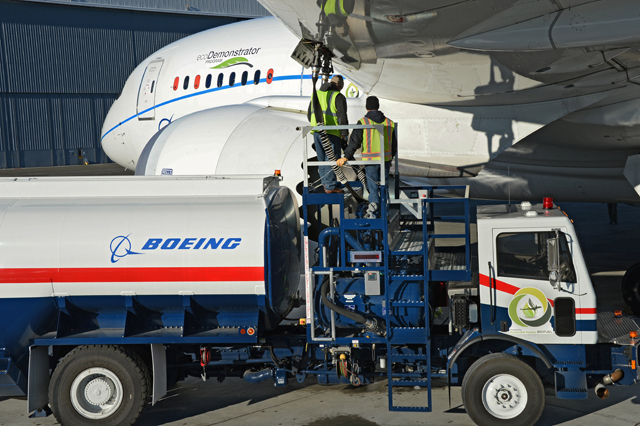Fresh from carrying out the first flight to be powered by a blend containing yet-to-be certificated green diesel, Boeing has high hopes for the potential of this type of fuel, and is confident it will be approved for commercial use later this year.
The airframer in December used its ecoDemonstrator 787 test aircraft to operate 10 flights fuelled by a blend comprising 15% green diesel and 85% Jet-A. The first flight used the blend in just the left engine, but the subsequent nine flights used it in all tanks of both engines.
“This is very important and speaks to the confidence that Boeing has in green diesel’s potential as jet fuel. It is very rare to use an unapproved fuel in all engines for test flights,” says Boeing Commercial Airplanes managing director of environmental strategy and integration Julie Felgar.
Following the test flights, Boeing’s chief pilot for product development, Mike Carriker, said the aircraft “performed as designed with the green diesel blend, just as it does with conventional jet fuel. This is exactly what we want to see in test flights with a new type of fuel”.
Green diesel is derived from vegetable oils, waste cooking oil and animal fats, and shares many of the same properties as hydro-processed esters and fatty acids (HEFA) fuels, which have already been approved for use in commercial aviation. One key difference is that the method of making green diesel is shorter than the HEFA process, as the last stage of the HEFA process can be skipped.

The ecoDemonstrator used the blend in 10 test flights in December
Boeing
“Because [green diesel] doesn’t require the final stage of HEFA, costs are lower and yields are higher,” Boeing’s director of environmental policy and strategy for Europe, Richard Mills, told delegates attending the Royal Aeronautical Society’s Greener by Design and Propulsion conference in October. “At the moment, if one looks at global production, green diesel already exceeds 1% of [global] aviation’s needs, so it can immediately provide a very significant source of alternative fuel.”
Felgar says Boeing is targeting approval of green diesel by certificating body ASTM International in 2015. “Discussions about green diesel approval are about amending the HEFA specification to enable the use of green diesel, rather than designating green diesel as a new type of fuel, as we saw with farnesane,” she adds.
At this stage, Boeing has no plans to conduct further green diesel flights using a higher blend ratio, although “that could change if there’s a reason to do it”, says Felgar. The green diesel used in December’s flights was produced in Europe by Finland-based Neste Oil, and “there is obviously a cost in dollars and time to transport it to Seattle for test flights”. The fuel was blended by Epic Aviation.
“We’re told that current global production capacity is more than 800 million gallons and is expected to grow,” says Felgar. “Approval for green diesel’s use in commercial aviation would add a market for green diesel producers and another potential reason to expand.”
In the USA, a government incentive scheme means that green diesel can be “sold at fossil parity”, so “potentially you have a very interesting proposition”, says Mills. “In Europe, those incentives are not in place – we need to think about creating a level playing field for aviation’s use of this fuel.”
For green diesel and other sustainable aviation fuels to progress, petroleum companies are “critical”, according to Jennifer Holmgren, chief executive of alternative energy producer LanzaTech. “There is a tremendous amount of infrastructure in place, it would be a shame to have to rebuild it,” she says.
Speaking on behalf of such companies, John Cooper, director of European biofuels strategy at BP Refining & Marketing, says it “takes a sustained effort and commitment to be in the business of blending fuels and meeting regulations”. He encourages the aviation industry to seek help from the road transport sector and develop the fledgling biofuels market, noting that road transport “should be seen as partnership, not competition”.
Source: Flight International























